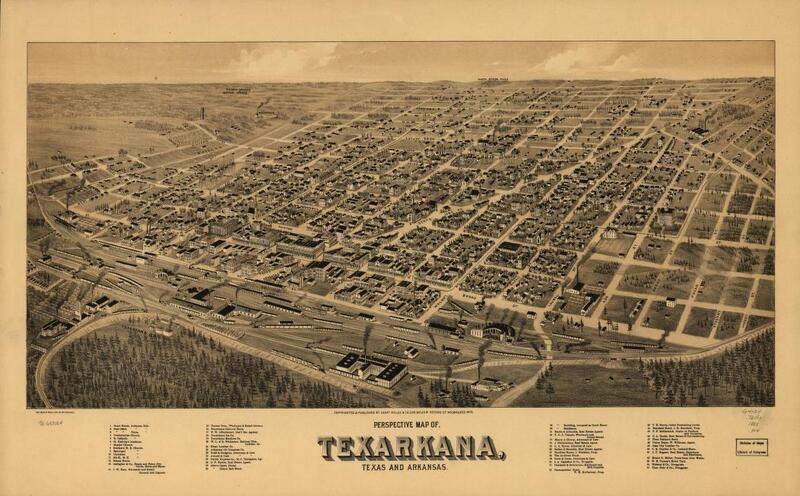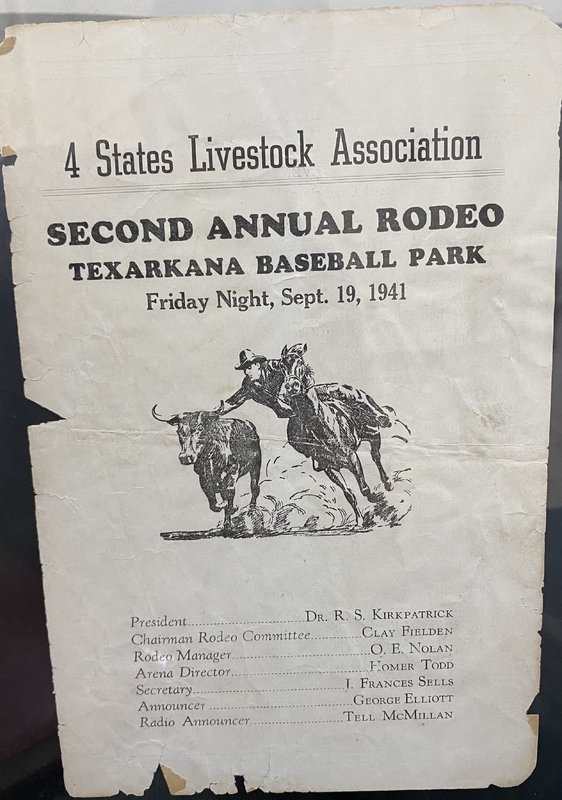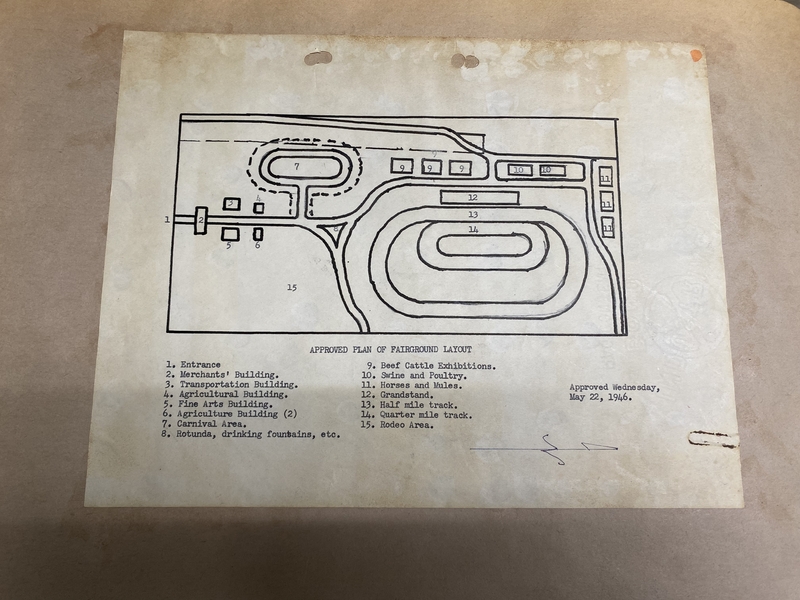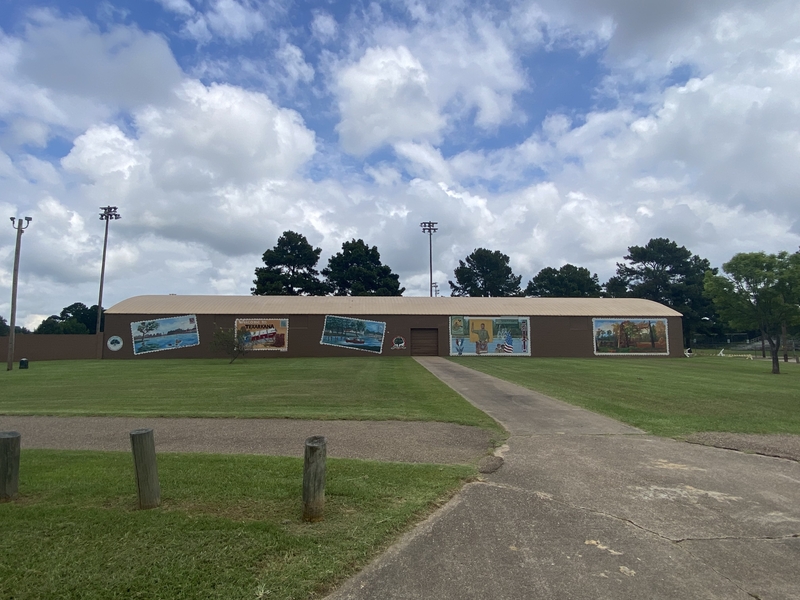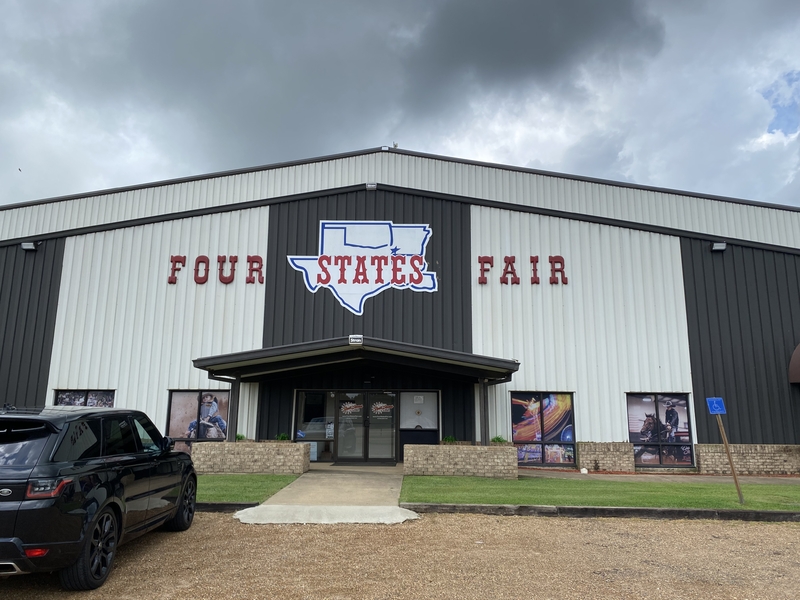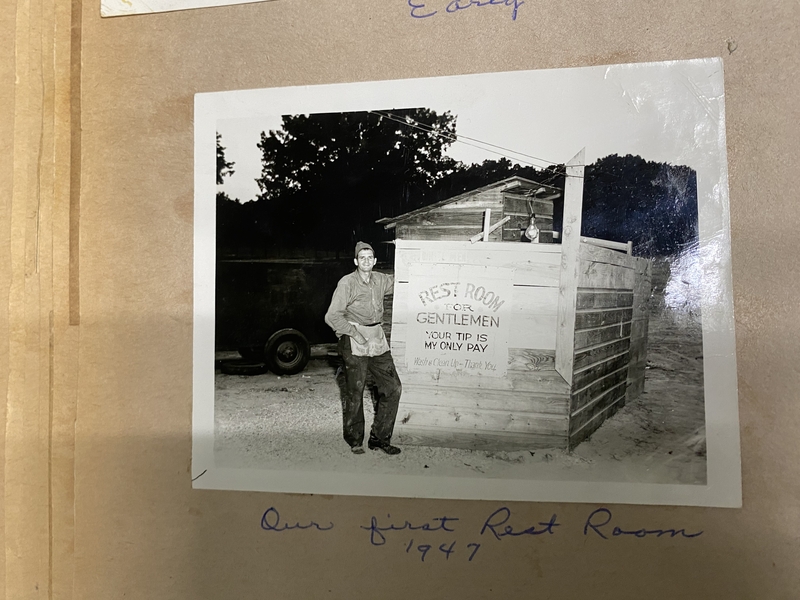The Two-State City with a Four-States Fair
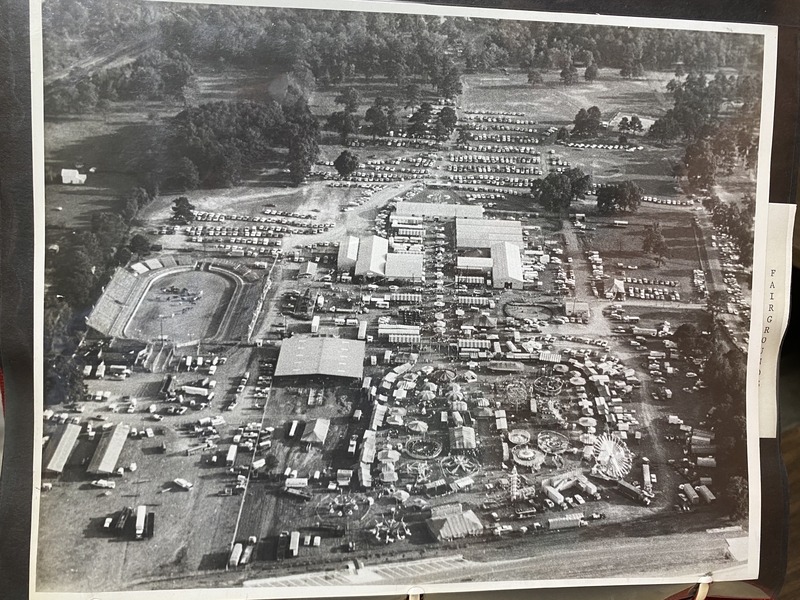
Texarkana, Texas, is located in the far northeastern corner of the Lone Star State in Bowie County. Its twin, Texarkana, Arkansas, is just across the state line in Miller County. Together, these twin cities form one metropolitan area that feels like a single town in east Texas or southwest Arkansas. However, they each have their own mayors, city councils, fire departments, and police forces. Despite this, they share a water utility company, a justice center, and—most famously—a U.S. Post Office and Federal Courthouse. The latter two buildings straddle the state line, with each side serving its respective state. This bi-state split was due to the meeting of two major railroads at the Arkansas-Texas state line in 1873, making it a strategic site to establish a railroad town.[2] The city’s location is a natural intersection of interstate commerce and is the economic center of the broader “Ark-La-Tex” region.
According to an 1888 perspective map of Texarkana, the area was book-ended by the railroad depot to the south and Wooten Spring Park to the north on the Texas side.[3] This is likely the present site of Spring Lake Park since the neglected Wooten Springs Cemetery sits just to the east of the railroad tracks. This cemetery was originally a part of the park before the railroad came through and cut it off from the main body in 1880. As the park went through two name changes, Wooten Springs Cemetery sat quietly across the tracks, keeping its original name, which likely dates back to 1871.[4] An Italian immigrant by the name of Anthony L. Ghio (1849-1917), who was one of the original buyers of Texarkana’s first lots in 1873 and later served as Texarkana, Texas mayor from 1880 to 1886, built a resort at the site of Wooten Springs called Ghio Park sometime after his mayorship.[5] In 1924, the site, with its spring-fed lake, officially became a city park with a more fitting name.[6]
Spring Lake Park would be the site of the first Four States Fair & Rodeo, which was chartered and organized on March 6th, 1945.[7] Lisa Garner, Executive Director of the fair, tells us that several locals who lived in the 1940s claim that there was an unofficial fair held in the College Hill area–south of the railroad depot–in the years before 1945. Among these locals is the former mayor and long-time member of the Texarkana, Arkansas city council, Londell “Kingfish” Williams, who was born in 1936.[8] There is direct evidence of a “second annual rodeo” held on September 19th, 1941, at the Texarkana Baseball Park. The rodeo was put on by the Four States Livestock Association and included bronco riding, “bull dogging,” calf roping, and bull riding. There also appears to have been entertainment sections put on by a man named Charlie Schultz, who would perform “trick riding and fancy roping” and various other stunts between the competitive events. Most of the entrants were from either Texas, Arkansas, or Oklahoma, with just a few from the subjectively defined “Four States area.” Surprisingly, there was only one contestant from Texarkana itself by the name of E.M. Watts and one from Louisiana, even though there were contestants from as far away as California, Idaho, and Canada.[9]
It is unclear whether or not the rodeo continued through the years of World War II, but there is a large body of primary sources about the October 1945 Four States Fair & Rodeo. Indeed, just one month after the war ended, Texarkanians were ready to get back to leisure and entertainment at their regional fair. On October 6th, 1945, a local newspaper published a proclamation signed by Texarkana, Texas mayor William V. Brown and Texarkana, Arkansas mayor Searcy H. Atkinson that “Texarkana and other communities in surrounding areas have established such an exposition under the title of The Four States Fair, same to be held at Spring Lake Park from October 9 through 14.”[10] The fair was opened at 1 P.M. on Tuesday, October 9th, by a downtown parade that began on the Arkansas side at Laurel and Broad Street and ended on the Texas side at Texas Avenue and 6th Street. The Four States Fair Parade reflected the optimistic sentiments of post-World War II America. The parade featured “the prancing, spirited rodeo horses” ridden by the rodeo performers, “Arkansas and Texas highway patrolmen in their official cars,” followed by the Arkansas High School band, new equipment from the Texas and Arkansas fire departments, and the mayors of both cities. The Texarkana Boy Scouts carried “the flags of the United Nations,” followed by the Texas High School band and the Girls Scouts and Humane Society Float. Twelve members of the Delta Beta Sigma and Beta Delta Sororities rode in a “Tally-Ho pre-automobile vehicle” dressed in cowgirl costumes.[11]
Given that these were the days of Jim Crow, it is no surprise that the parade was not just segregated, but African Americans were to put on an entirely separate parade on October 13th, designated as “Negro Day.” The parade took place in the city’s business district and was supposed to feature Stepin Fetchit, the famous African American screen comedian and “his boogie woogie orchestra.” However, according to an October 12th headline, Fetchit was unable to make it to Texarkana. Like the white parade, the African American counterpart started on the Arkansas side and followed a similar path across Stateline Avenue to Texas Avenue. The agricultural competitions within the fair itself were also segregated. One headline notes “Negro Section To Make Good Fair Showing” and goes on to describe the various competitions planned for black participation. African Americans entered “agricultural, educational, textile, home pantry, and farm shop exhibits” at the fair. A total of $303 in cash prizes and ribbons were awarded to the winners, which were announced on October 13th in a local newspaper.[12] There is no evidence that African Americans participated in the livestock shows or the rodeo.
The 1945 Four States Fair & Rodeo was expected to attract over fifty thousand visitors throughout the week. On opening day, more than ten thousand people were recorded going through the fair gates, eight thousand on Wednesday, and seven thousand on Thursday. The large crowds created traffic jam issues and fair organizers had to add more staff at the ticket offices before the weekend.[13] This was despite the road leading into Spring Lake Park being paved one month before the fair and the city providing three extra buses leaving every twenty minutes from downtown to the fairgrounds. Private cars were also accommodated. Drivers were given the choice to park inside the fairgrounds for a charge of twenty-five cents per car.[14] The large turnout comes as no surprise, given the equally large promotional effort. The cattle judges hired for the event had impressive pedigrees in the livestock industry. John C. Burns, president of the Southwest Livestock Exposition and Fat Stock Show, judged the beef entries, and Joe W. Ridgeway, who for ten years was head of the dairy department at Texas A&M University in College Station, judged the dairy cattle. These two men had been judges at the International Fat Stock Show in Chicago, The American Royal Show in Kansas City, The Centennial Fat Stock Show in San Francisco, and the Denver, Fort Worth, Houston, and Dallas Fat Stock Shows.[15] Indeed, the Four States Fair Association seems to have pulled out all the stops to get people to show up. A September 20th paper emphasized the educational and economic value of the fair as articulated by Miller County agent John W. Measel:
"The fair or livestock show means much more to farmers and stockmen than just a place of entertainment. The Four States Fair will enabel farmers and stockmen to study the best of a type in order to know the goal to strive for in producing better livestock and crops. The major goal of a fair is its educational value to the hundreds that come to see the exhibits. Many farmers might be satisfied with scrub livestock and corn nubbins until they see the fine livestock and outstanding products exhibited by other farmers.[…] The sleek, well-kept appearance of the animals exhibited creates a desire for ownership in all those that observe, and in this way good bloodlines are carried to the remote communities.[…] The value of this type of show is hard to estimate because its influence reaches much further than those who exhibit and observe."[16]
Measel was correct that The Four States Fair brought incalculable value to the Texarkana area, evident by the fact that the fair still continues to this day and has only expanded. The value that could be calculated was reported in a local newspaper on January 6th, 1946, stating that the Four States Fair Association had $35,692.66 in its treasury from donations to the permanent fair fund and profit from the October 1945 event.[17] This was an auspicious start to the first official fair in the four states area and would mirror the growth of the broader post-war United States until it finally outgrew Spring Lake Park. It is fitting that the site of Texarkana’s regional fair has been in both Texas and Arkansas. In the 1980s, the fair was moved to the Arkansas side within the bounds of Bobby Ferguson Park and now boasts a seventy-thousand square foot arena with 4,794 permanent seats, a fine arts building, and an ag learning center.[18] Fair-goers today enjoy much more than livestock shows, carnivals, and rodeos. The Four-States Fair Arena hosts monster trucks, demolition derbies, motorcycle stunts, and even hosted Texarkana’s hockey team from 2000 to 2001 and then from 2003 to 2006. I personally have fond memories of watching these events in my youth. Every September my family and I would go to ride “The Zipper” and enjoy bumper cars at the carnival before watching barrel racing and bull riding at the rodeo. In 2021, The Four States Fair weathered a pandemic with little more than a schedule change (it now takes place in April instead of September), showing the resilience and popularity of this unique and time-honored event.
Images

